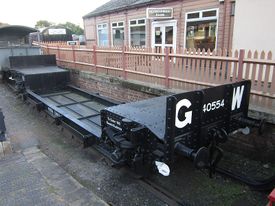GWR 40554 Chaired Sleeper Wagon
| GWR 40554 Chaired Sleeper Wagon | |
|---|---|
 GWR 40554 Chaired Sleeper Wagon | |
| Built By | GWR Swindon |
| Status | Operational |
| Number | 40554 |
| History | |
| Built | 1895 |
| Diagram | T1 |
| Lot | 245 |
| Type | 4-wheel well wagon |
| Capacity | 18 tons |
| Telegraphic code | n/a |
| 1973 | Preserved on SVR |
| 1985 | GWR 150 main line appearance |
| 2011-12 | Overhaul |
Permanent way trains mainly required wagons used for moving rails (Diagram J), ballast (Diagram P), and sleepers (Diagram T). 40554 is a special type of well wagon intended for moving chaired sleepers. The well deck floor and end decks are made of steel plates, while tall side stanchions allow the load to be stacked quite high. This results in a capacity of 18 tons, equivalent to 160 chaired sleepers.
Contents
Contents
Service
40554 was built by the GWR at Swindon between 1895 and 1899 to Diagram T1, Lot 245.[1] It was originally used for moving chaired sleepers from the Hayes Creosote Depot in Middlesex. During BR service it was adapted for moving concrete products from Taunton, but post-preservation it has been restored to its original configuration[2].
Preservation
40554 was acquired from Swindon Works in 1973 where it was awaiting scrapping, arriving on the SVR on 3 July.[2] After arrival it was used by S&T for mole-ploughing (installing underground cables alongside the railway) and by both S&T and P-Way for material movement and storage, for which it was fitted with a false floor of wooden sleepers.
In August 1983 40554 received a quick (single coat) repaint in GWR engineers black livery and replicas of the original cast plates on the sides were fitted. The ends were also lettered, a modification which was a later addition.[3] Two years later, 40554 was one of 28 wagons inspected by BR C&W inspectors from Bescot at the end of August prior to their use in the forthcoming GW 150 demonstration freight train. 25 of the wagons including 40554 were passed fit to run subject to pad exams and other items requiring attention such as broken buffer springs and bent axle guards. Over the next 8 days the jobs were completed with many hours of work by a combination of volunteers and permanent staff, and 40554 duly appeared on the main line in the demonstration freight train which ran to Newport behind GWR freight loco 2857 on 10 September 1985.[4]
Apart from the quick repaint in 1983 and routine running maintenance, 40554 had received no serious attention until an overhaul began in autumn 2011. This was originally conceived as a project for the Junior Club, involving clearing the wagon of the 'junk' stored on it and repainting it black. They achieved this admirably, quickly removing the additional rotten 'floor' of sleepers. However inspection then revealed that its use since arrival had made 40554 probably the most abused historic wagon on the SVR. The mole-ploughing had resulted in stanchion bracket damage, while the false rotten sleeper floor had resulted in significant corrosion to the well floor and ends. The latter, consisting of 1/2" plate, had rotted through in places. The side-chain pockets were also well beyond repair.
Structural repairs involved repairs to the well ends, replacing and re-riveting the deck plates at either end and then renewing and re-riveting the steel well deck floor. The latter operation required the wagon to be jacked up to gain enough room to work underneath; using the loco dept. prep pit was not an option as the edge row of rivets would have been directly above the rail where working height would have been insufficient. Other work included the repair of corroded/damaged stanchion brackets, and the fitting of replacement side-chain pockets using new formed sections. After a number of minor snagging issues were attended to, 40554 was finish-painted and released back into use at the end of 2012.[5]
40554 is owned by The GWR 813 Preservation Fund and is shown in the photograph at Bewdley. The Railway Heritage Register Wagon Survey suggests this is the only surviving example of this particular type of well wagon.